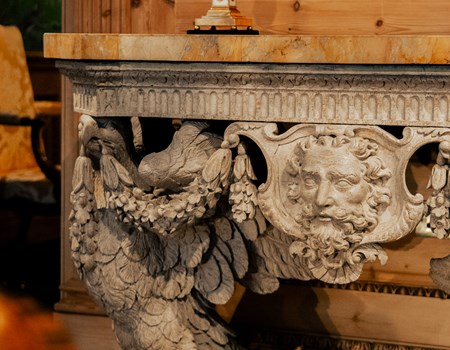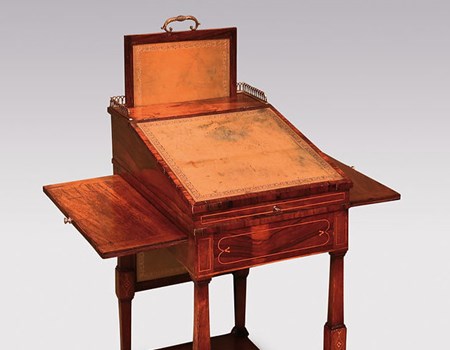Design or Collectable Comfort?
 READ MORE
READ MORE
The Dutch Eye: Inside the Legacy of Kunstgalerij Albricht
 READ MORE
READ MORE
From the V&A to the Fair: Dr. Jin Gao’s Digital Perspective on Art
 READ MORE
READ MORE
Authenticity on Trial: The Story Behind Long-Sharp Gallery
 READ MORE
READ MORE
The Refuel Café: A Creative Collaboration with Firmdale
 READ MORE
READ MORE
Can a Rock be a Work of Art? Inside the legacy of Stone gallery
 READ MORE
READ MORE
Contrasting Perspectives on the Islamic Arts Biennale 2025
 READ MORE
READ MORE
Four Decades in the Antique Furniture World
 READ MORE
READ MORE
Pioneering the Vintage Omega Market
 READ MORE
READ MORE
A Journey Through Japanese and Indian Art
 READ MORE
READ MORE
 READ MORE
READ MORE
Tax Changes: The Budget's Impact on the Art World
 READ MORE
READ MORE
 READ MORE
READ MORE
Dora Carrington: Beyond Bloomsbury
 READ MORE
READ MORE
Flaws as Insight: The perfection of imperfection in art
 READ MORE
READ MORE
 READ MORE
READ MORE
Q&A with Dara Huang: Architect, Designer and Entrepreneur
 READ MORE
READ MORE
An interview with Catherine Milner: The Fair Tour Guide
 READ MORE
READ MORE
 READ MORE
READ MORE
 READ MORE
READ MORE
I Will Rise: The Rise of the Female Sculptor
 READ MORE
READ MORE
 READ MORE
READ MORE
 READ MORE
READ MORE
 READ MORE
READ MORE
 READ MORE
READ MORE
 READ MORE
READ MORE
 READ MORE
READ MORE
 READ MORE
READ MORE
 READ MORE
READ MORE
 READ MORE
READ MORE
 READ MORE
READ MORE
 READ MORE
READ MORE
The Ladybird Book, Wikipedia in Technicolour
 READ MORE
READ MORE
 READ MORE
READ MORE
 READ MORE
READ MORE
 READ MORE
READ MORE
 READ MORE
READ MORE
 READ MORE
READ MORE
Beneath the Surface - the Power of Infrared Imaging
 READ MORE
READ MORE
 READ MORE
READ MORE
 READ MORE
READ MORE
The Cult of the 21st Century First Edition
 READ MORE
READ MORE
 READ MORE
READ MORE
 READ MORE
READ MORE
Where the Value of Silver Lies
 READ MORE
READ MORE
 READ MORE
READ MORE
Design or Collectable Comfort?
 READ MORE
READ MORE
The Dutch Eye: Inside the Legacy of Kunstgalerij Albricht
 READ MORE
READ MORE
Authenticity on Trial: The Story Behind Long-Sharp Gallery
 READ MORE
READ MORE
The Refuel Café: A Creative Collaboration with Firmdale
 READ MORE
READ MORE
AtKris Studio: A Living Dialogue Between Past and Future Design
 READ MORE
READ MORE
Four Decades in the Antique Furniture World
 READ MORE
READ MORE
Reviving Arts and Crafts for a New Generation
 READ MORE
READ MORE
Between the Earth and the Divine
 READ MORE
READ MORE
 READ MORE
READ MORE
The Art of Ingenious Table Furniture
 READ MORE
READ MORE
 READ MORE
READ MORE
 READ MORE
READ MORE
 READ MORE
READ MORE
 READ MORE
READ MORE
 READ MORE
READ MORE
 READ MORE
READ MORE
 READ MORE
READ MORE
 READ MORE
READ MORE
American Craft in collectors' hearts
 READ MORE
READ MORE
 READ MORE
READ MORE
 READ MORE
READ MORE
 READ MORE
READ MORE
 READ MORE
READ MORE
 READ MORE
READ MORE
 READ MORE
READ MORE
 READ MORE
READ MORE
 READ MORE
READ MORE
 READ MORE
READ MORE
Are Brooches Becoming the New Tiaras?
 READ MORE
READ MORE
Pioneering the Vintage Omega Market
 READ MORE
READ MORE
The Power of Pink: Why we can’t shake the eternal allure of pink diamonds
 READ MORE
READ MORE
Katherine Purcell Invites Us Inside Wartski
 READ MORE
READ MORE
 READ MORE
READ MORE
 READ MORE
READ MORE
 READ MORE
READ MORE
 READ MORE
READ MORE
Where the Value of Silver Lies
 READ MORE
READ MORE
 READ MORE
READ MORE
 READ MORE
READ MORE
A Journey Through Japanese and Indian Art
 READ MORE
READ MORE
 READ MORE
READ MORE
 READ MORE
READ MORE
 READ MORE
READ MORE
 READ MORE
READ MORE
 READ MORE
READ MORE
 READ MORE
READ MORE
 READ MORE
READ MORE
 READ MORE
READ MORE
 READ MORE
READ MORE
 READ MORE
READ MORE
 READ MORE
READ MORE
 READ MORE
READ MORE
 READ MORE
READ MORE
 READ MORE
READ MORE
 READ MORE
READ MORE
 READ MORE
READ MORE
 READ MORE
READ MORE
 READ MORE
READ MORE
 READ MORE
READ MORE
 READ MORE
READ MORE
 READ MORE
READ MORE
 READ MORE
READ MORE
Q&A: A Lighthouse Called Kanata
 READ MORE
READ MORE
 READ MORE
READ MORE
Dora Carrington: Beyond Bloomsbury
 READ MORE
READ MORE
 READ MORE
READ MORE
 READ MORE
READ MORE
 READ MORE
READ MORE
Contemporary Chinese Ink Paintings
 READ MORE
READ MORE
 READ MORE
READ MORE
 READ MORE
READ MORE
 READ MORE
READ MORE
Beneath the Surface - the Power of Infrared Imaging
 READ MORE
READ MORE
 READ MORE
READ MORE
 READ MORE
READ MORE
 READ MORE
READ MORE
 READ MORE
READ MORE






































































































